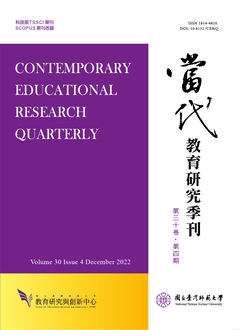

本研究探討三個研究問題。第一是台灣六年級學生在不同代數試題表徵(故事、文字、符號)解題表現。第二是國小數學教師對這三類試題表徵的教學佈題序列及背後的教學信念。第三是學生的解題表現與教師信念之間一致性檢驗。研究結果發現(1)在相同數學內涵之下,國小六年級學生在符號題表現最好,故事題表現最差。但進一步分析發現學生雖在符號題的答題較佳,代數思維的發展仍未臻成熟。(2)約80%國小數學科教師的佈題順序為符號、文字、故事題,且具有符號優先教學觀 (symbol-precedence view)。這些老師認為學生在符號題表現較好,文字題應直接教導正確解題法或先熟悉符號操作過程,也較贊同代數方程式是解決故事或文字題最有效的方法。剩下20%的教師則是認為應先教學生故事題,其教學信念明顯的偏向非符號優先與非示範解題法的教學觀。(3)進一步比較教師佈題順序及代數教學信念與學生解題表現的一致性,發現教師無法完全準確的預測學生的答題表現。甚者,教學信念偏向非符號優先與非清楚示範解題法的教師,預測學生的答題表現最不準確。
This paper presents three investigations related to algebra problems: (1) Taiwanese sixth graders’ problem-solving performance on story problems, word-equation problems, and equation problems; (2) Taiwanese mathematics teachers’ posing sequences towards these problems and their hidden teaching beliefs; and (3) the relationship between students’ performance and teachers’ beliefs. These analyses revealed that sixth graders performed the best on equation problems and the worst on story problems. Further investigation indicated that although students performed better on equation problems, their algebraic thinking was still not well-developed. Second, about 80% mathematics teachers posed problems with the sequences of equation problems, word-equation problems, and story problems, respectively; they preferred the symbol-precedence view. They thought equation problems were easiest for students, and that word-equation problems should teach students how to directly find algebraic solutions and the procedures of algebraic operations. They also agreed that algebraic equations were the most effective way to solve story problems and word-equation problems. The remaining teachers, who expressed a non-symbol-precedence view, believed that story problems should be taught first. Third, the comparisons showed the inconsistency between students’ performance and teachers’ predictions, especially those teachers with a non-symbol-precedence belief made the worst predictions.

本著作係採用創用 CC 姓名標示-非商業性 3.0 台灣 授權條款授權.
本刊國立台灣師範大學教育研究與創新中心
106台北市和平東路一段162號 | 電話: 02-7749-3670 | E-mail: cerecerq@gmail.com
教創中心 | 師大 | 電子報 | 線上投審系統
本刊由國家科學及技術委員會人文社會科學研究中心補助經費
© 2014 CERI-NTNU
